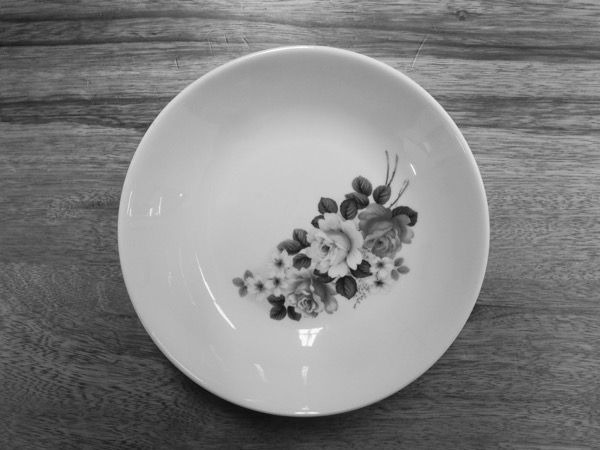Omer Israel Landoy | An Old Story, a Dream and a Ladder
For the text in Hebrew press here
‘All things of grace and beauty such that one holds them to one’s heart have a common provenance in pain. Their birth in grief and ashes.‘ – The Road, Cormac McCarthy
Let’s start with the Kibbeh (though this is not really a “beginning” and might actually be the end).
It’s colorful, and it’s a home. It’s placed on a dining table that is covered with a floral tablecloth. Beside it, in gray, a flower-decorated plate. It too, is placed on a wooden table that has groves from use. A hand (Omer’s) cradles two strawberries, a sage leaf, photographic film, and a cable stub (not necessarily in that order). These things are important, the little things. They are important beyond their symbolism in his life or in this story we are now telling. They are important enough for him to hold in the palm of his hand. There is also a cigarette butt, it isn’t Omer’s, but he doesn’t discriminate. It was smoked by someone. This someone was here. Before the person who took the picture, and before us, watching now.
A wall in fog. Cold and wet daylight. Gray as his heart.
He writes about a conversation held in a hallway with dazzling light. between him and someone. He peeks through a net at the entrance of a house. Whose house? we do not know, but we peek together with him. We miss something, and don’t remember why. There are many houses, buildings stuck in limbo, forgotten in unfinished construction and disassembly processes. Lacking entrances and devoid of people and animals. Time feels slow as if Omer has been standing there for a long time. Within him, something that has long been forgotten, stirs. A concrete road that has once led someone somewhere, now leads no-one to anywhere. A feeling of searching for something, and it’s also so quiet, in this world in which he walks.
Where are the people?
His soil is not what we would like to think of as nature. In this world where we walk with him, it is barren and dry, growing plants that are hostile to man, and nowhere can we find a place to rest our head. The Camellia is tired and covered in road dust. It’s the protagonist of Omer’s old story, his alter-ego, a self portrait. The plants are in varying degrees of bloom and artificiality. They’re on the tablecloth, on the plate. They are seeds in the palm of his hand; they wither.
They are a promise of a beginning.
There are moments of rest between the thorns, the struggling fig tree, the bush in the concrete lake, and the dry herbs. A bright white bud survived the event that created such a silent world. A Camellia blossoming into a hazy cloud of light. Light up the ladder. At the end of the road, we will reach the sea. The road feels warm, and the water is milky.
“And there was that step
Of all others, accompanied by a sense of relief
Followed by a deep breath.”
He writes to himself between the pages of his diary, with his pictures he leaves us small stepping stones to rest in the moving river. He writes down his thoughts in a small notebook. Later he writes with ink and a pen-nib on the images. His handwriting is important, and so is the material he chooses to use. His thoughts are profound and immense at times and also small and fleeting; full of self-awareness and humor, they save us, for a moment, from sinking into his dream. There is another wakefulness world, and there is a different story to tell.
Where is the end?
There is no end. Maybe we’re actually talking about endings and beginnings (in other words, boundaries), about when something becomes one thing or another, about cycles, hardship, and its connection to small moments of grace between a person and his world, a person and himself. Things are not unequivocal in his photographs (and in the world in general, apparently). Nature takes on a rigid form, and the rough concrete evokes longing at the entrance of an old house. He writes down a childhood memory accompanied by exposed concrete castings that provide nowhere at all to rest. And the light isn’t forgiving either. Barren soil becomes fertile, and so forth. The concrete is neglect, and the concrete is a promise. It is forgotten and is also home, and home is present but inaccessible. Home also occupies a dream – it is under construction, in use, and abandoned, all at the same time. Omer reverses inside and outside, roles and meanings, when something is alive and when it is a remnant, when it’s essential and when it is forgotten, when it’s functional and when it’s just a relic.
And the relics are also appreciated; he covers them with the palm of his hand and guards them. The wooden peg and the rose thorn as well (and we are the peg, and we are the thorn that rest in the palm of his hand).
Omer’s work mirrors the human psyche’s duality, this specific one, and in general. If we were to turn his skin and the inside was outside, what would we see (what we see hanging on the walls)? A soul that can feel everything simultaneously, ache happiness and be saddened by beauty, and also miss what is here right now. The abandoned and hopeful, the weariness and road dust, the forgotten behind but kept close, the places where it’s scratched and spoiled, the delicate, deep, sincere, touching beauty.
There is a promise in the bud and a process in the wilting rose. A rose stub, a rose thorn, a petal.
The end.
